#Österreichische Nationalbibliothek
Explore tagged Tumblr posts
Text

Study of a Lizard, a Chameleon, and a Salamander, Giuseppe Arcimboldo, 1553
#art#art history#Giuseppe Arcimboldo#animal study#figure study#reptiles#lizards#amphibians#herpetology#watercolor#gouache#Renaissance#Renaissance art#Italian Renaissance#Late Renaissance#Cinquecento#Italian art#16th century art#Austrian National Library#Österreichische Nationalbibliothek
90 notes
·
View notes
Text



Easter Moralized
This Easter (which, btw, in 2024 is also International Transgender Day of Visibility) we explore the gilded pages of the Vienna Bible Moralisée (moralizing bible), of which we hold the first full-color facsimile published in 1973. The Vienna Bible Moralisée is also known as Vienna 2554, referencing its current place of residence at the Austian National Library in Vienna. One of only three 13th-century moralizing bibles still in existence, this manuscript is an excellent example of the of the ways in which Christians worked to simplify the lessons of the Bible for those that were not theological scholars. Even though they were made to be more accessible, these types of manuscripts were only created for the wealthy class; they needed to understand the Christian Bible and its lessons to ensure that they were (theoretically) promoting moral behavior. Vienna 2554 is thought to have been commissioned by Phillip II Augustus, for his son, Louis VIII or his bride, Blanche of Castile.
The Bible Moralisée is curious for two reasons: it does not actually contain the entire text of the Christian Bible, and it is mostly filled with images, rather than with words. These specific attributes contribute to the accessibility of Christian morals by abbreviating biblical stories and using illuminations to visually represent them.
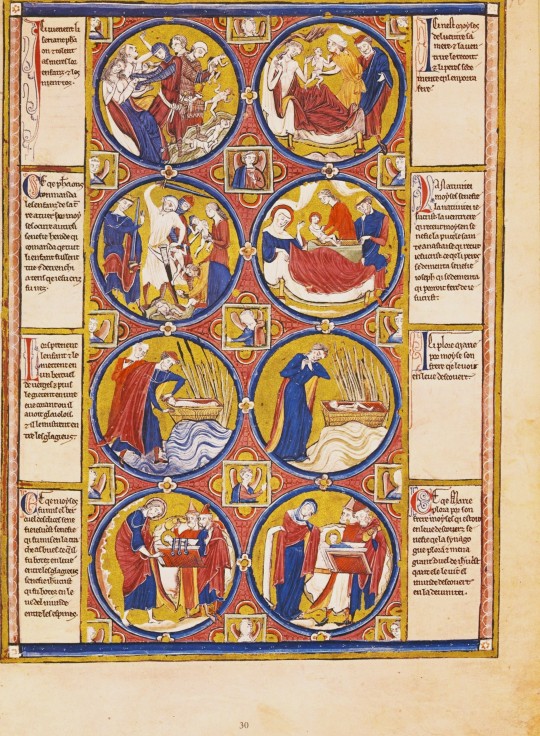
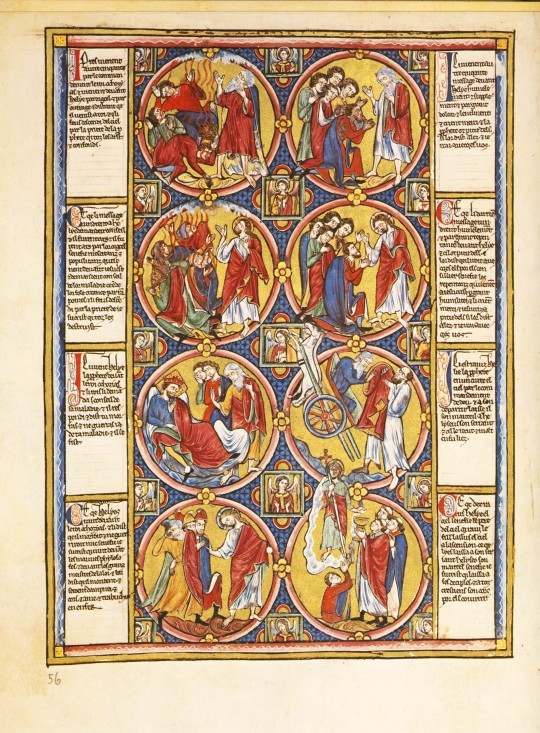
Interestingly, the designs on the pages of these bibles imitate stained glass representations at the time: the eight medallions placed in columns of four; the inclusion of quatrefoils in between these medallions; the use of vivid colors. This reflection of architectural design in the illuminations may have allowed people to visualize themselves in a church and may have led to more contemplative readings of the text that emphasized the teachings of priests and theologians at the time. One of the most well-known images in these types of bibles is Jesus as architect and creator of the universe. This type is seen on the frontispiece of this moralizing bible: Jesus is holding a compass as he focuses on the creation of the world. Geometry and astronomy were often associated with the divine in the Middle Ages and this viewpoint is well explained in Vanderbilt's Divinity Library website: "God has created the universe after geometric and harmonic principles, to seek these principles was therefore to seek and worship God."
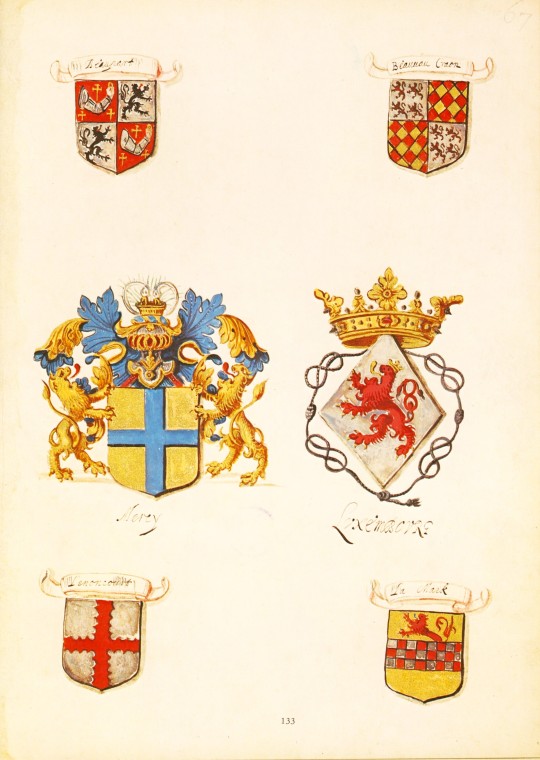
The creation of the moralizing bible also inspired later moralizing versions of books and poetry, like Ovid’s Metamorphoses. These types of moralizing volumes edited and changed parts of the works to make them conform to Christian teachings oft the time.
Our facsimile was published in 1973 by the Akademische Druck- u. Verlagsanstalt in Graz, Austria in an edition of 3,000 copies at the manuscript's original size. To see the original manuscript, you can visit the Österreichische Nationalbibliothek in Vienna or view the entirety of the manuscript online on their website here.
View more manuscript posts.
– Sarah S., Special Collections Graduate Intern
#Easter#bible moralisée#vienna bible moralisée#vienna 2554#austrian national library#Österreichische Nationalbibliothek#moralizing bible#bible#Akademische Druck- u. Verlagsanstalt#Christian bible#facsimiles#manuscripts#illuminated manuscripts#medieval manuscripts#Sarah S.#International Transgender Day of Visibility
57 notes
·
View notes
Text









Österreichische Nationalbibliothek, Prunksaal (ceremonial hall). One thing I love about living in Vienna is that culture is not confined to a certain class. Many of these museums or historical palaces can be visited for free or have cheaper entrance fees.
#österreichische nationalbibliothek#austrian national library#vienna#prunksaal#photographic evidence#dark academia
7 notes
·
View notes
Text

Österreichische Nationalbibliothek
0 notes
Text
BILD MACHT POLITIK. Yoichi Okamoto. Ikone der Nachkriegsfotografie - große Sonderausstellung im Prunksaal der Österreichischen Nationalbibliothek
23. November 2023 – 3. März 2024 Europa 1945. Berühmte Fotograf*innen halten in eindrucksvollen Bildern fest, wie Europa aus einem durch das nationalsozialistische Regime entfachten Weltkrieg neu ersteht. Einer von ihnen war der amerikanische Fotograf Yoichi Okamoto (1915–1985), der im Frühjahr 1945 als Militärfotograf nach Europa kam und in Österreich zum persönlichen Fotografen des…

View On WordPress
#Österreichische Nationalbibliothek#General Mark W. Clark#Hans Petschar#Lyndon B. Johnson#Marlies Dornig#Yoichi Okamoto
0 notes
Text

ARCIMBOLDO, Giuseppe Nature studies - Watercolour on parchment Österreichische Nationalbibliothek, Vienna
115 notes
·
View notes
Text
What are Campanes ?

In part V of my article on the bedchamber I mentioned campane ornaments several time, without ever explaining what they are, in this post i will take the time to clarify that relatively obscure yet very popular type of ornamentation.
Campane ornaments, characterized by their distinctive bell-like shapes with tassels, are decorative motifs that bring rhythm and elegance to architectural and interior designs. These ornaments, typically arranged in repeating patterns along the edges of canopies, cornices, and valences, resemble stylized bells suspended in a linear formation. Their formal beauty made them a popular decorative choice across Europe, particularly in France, where they became symbols of opulence and grandeur during the reign of Louis XIV.
The origins of campane motifs can be traced at least to the 16th-century in Flemish Renaissance art, where early forms of these bell-shaped ornaments began appearing as decorative borders of canopies(fig 1).

Fig 1 : "Ester e Assuero," 16th-century Mannerist painter from Antwerp, oil on panel, 99 x 136.5 cm, Zambeccari Collection, Inventory No. 204, Pinacoteca Nazionale di Bologna
At the same period they can be seen in certain fashion ornaments, for instance around the knee of some of the heroic armours, designed to be references for the brass statues representing Emperor Maximilian's ancestors guarding his tomb (fig 2)

Fig 2 :Kölderer’s drawing from 152211 (Wien, Österreichische Nationalbibliothek, Cod. 8329, fol. 15)
By the second half of the 17th century, campane ornaments had spread widely across Europe, reaching peak popularity and becoming synonymous with Baroque decor. France embraced campane motifs with particular enthusiasm. They became integral to the decorative vocabulary of the French court and the broader Louis XIV aesthetic. In fact, the motifs became so prevalent that Swedish diplomat Daniel Cronström who was in France at the time wrote to Swedish royal architect Nicodemus Tessin in 1695, observing :
"The campane ornaments, made and trimmed, are now so much in fashion that one sees almost nothing else [Les campanes faites et gallonées sont maintenant si fort à la mode qu’on ne voit quasi que cela.]"
— Daniel Cronström to Nicodemus Tessin, January 7, 1695
Applications in French and European Decor
Architectural and Decorative Applications
Campane ornaments quickly became a feature in grand architectural settings, with Versailles as a prime example. On the cour de marbre façade of the palace, the upper cornice is lined with a continuous row of gilded campane motifs, creating a rhythmic elegance to the roofline and enhancing the palace’s imposing silhouette (fig. 3 and 4).

Fig 3 :Élévation de la façade nord sur la cour de Marbre et sur la Cour royale. Coupe sur la partie médiane, after 1682 AN O/1/1768/A, dossier 1, n°1

Fig 4 : Palace of Versailles drone view of the roofs on the cour de marbre facade.
They were also used in architectural interiors, where they added a rhythmic and opulent touch to cornices and molding. At the Hôtel de Chevreuse recreated in the Louvre (fig. 5), the campane motifs line the upper edge of the room’s panels, creating a visual continuity that highlights the room’s refinement, and seperation between the space of the alcove and te rest of the room.
In the King’s bedchamber at Versailles, campane ornaments also appear on the cornice that divides the room from its open attic (Fig. 6). Here, individual campane pieces punctuate the cornice, reinforcing the room’s formal symmetry and creating a unified aesthetic with the bed canopy below. This architectural application of campane motifs enhances the decorative richness of the space and underscores the room’s ceremonial significance, where every detail contributes to the regal atmosphere.

Fig 5 : Salle 622, Louvre Museum, originally the Parade Bedchamber of the Hôtel de Chevreuse.

Fig 6: detail of the cornice of the central salon in Versailles, who became the King's Grand Bedchamber in 1701.
Furniture and Coaches
Beyond architecture, campane ornaments adorned ceremonial furniture and royal coaches, reinforcing their association with prestige and authority. In Entrée à Arras by Adam-Frans van der Meulen (fig. 7), the canopy of Louis XIV’s royal coach is lined with campane valences, demonstrating how these ornaments were used to convey regal dignity even in mobile spaces.

Fig 7 :Detail of Entrée à Arras de Louis XIV et de Marie-Thérèse, 27 juillet 1667," Adam-Frans Van der Meulen, oil on canvas, 1680-1685, 232 x 331 cm, Château de Versailles, MV 6057
Printed Works
The influence of campane ornaments extended into printed works as well. In the 1669 engraving L'audience royale donnée aux nations étrangères by Nicolas I de Larmessin (fig. 8), campane motifs frame key elements around Louis XIV, emphasizing the structured hierarchy and formality of the French court. This engraving shows how campane ornaments permeated different artistic mediums, symbolizing authority in both the real and the representational worlds.

Fig 8 :L'audience royale donnée aux nations étrangères, almanach 1669," Nicolas I de Larmessin, engraving, edited by Pierre Bertrand, 1669, Musée du Louvre, Paris.
Adoption Across Europe: Sweden and Germany
The popularity of campane ornaments wasn’t confined to France; they became fashionable across Europe, especially among designers who admired the grandeur of French decor. For example, Daniel Cronström and Nicodemus Tessin, influential Swedish designers, corresponded extensively about incorporating French styles into Swedish architecture. Cronström’s aforementioned letter reflects this enthusiasm, showing that campane ornaments were a pan-European trend embraced by Francophile designers.
In Germany, campane ornaments also found a place in the Margravial Opera House in Bayreuth, where a grandcanopy is adorned with these motifs (Fig. 9). This example demonstrates the cross-cultural appeal of campane ornaments.

Fig 9 : Detail of the canopy at Margravial Opera House in Bayreuth
Campane Valences on Royal Beds
The ultimate prestige of campane ornaments lies in their use as valences on royal beds, transforming these canopies into symbols of authority and ceremony. In Louis XIV's France, royal beds were not merely functional pieces but ceremonial centers where kings and queens held court, making them a focal point of royal power.
Examples in Royal Bedchambers
Campane valences on royal beds can be seen in early examples, such as Louis XIV’s bed at Trianon (circa 1700, Fig. 10) and his bedchamber at Marly (1692, Fig. 11). These valences framed the bed, accentuating its importance and creating a sense of regality around the sleeping area. The presence of campane ornaments on these beds marked them as spaces of prestige, emphasizing the central role of the monarch’s bedchamber in court life.

Fig 10 :BnF, Dept. Est. FOL-VA-78 (G, 2)

Fig 11 :BnF, Dep. Est. RESERVE HA-18 (40)-FOL
The 1701 King’s Bedchamber at Versailles
One of the most iconic uses of campane valences on a royal bed is found in the 1701 bedchamber at Versailles (fig. 12, 13 and 14). Here, the bed’s canopy was adorned with an intricate campane valence, framing the area where Louis XIV conducted his lever and coucher ceremonies. These daily rituals, in which courtiers observed the king’s rising and retiring, were significant court events. The campane valences on this bed reinforced the ceremonial function of the space, creating a structured grandeur around the king and emphasizing his authority.

Fig 12 : Drawing of the King's bedchamber(Louis XIV) in Versailles(after 1701) National Museum, Stockholm, NMH CC 174

Fig 13 :François Marot, "Institution de l'ordre militaire de Saint-Louis, 10 mai 1695," 1710, oil on canvas, Château de Versailles, Inventory No. MV 2149.

Fig 14 : Mention of the campane valences in the description of set 1881 present since 1701 in the King's grand bedchamber AN O1 3446 fº 381 vº
Transition to Festoons in the 18th Century
By the end of Louis XIV's reign, changing tastes led to the gradual replacement of campane valences with festoon-shaped valences, as seen in the 1714 bedchamber at Fontainebleau (Fig. 15). This shift reflected the emergence of the Rococo style’s preference for softer, more organic forms. Although campane ornaments were no longer in fashion, their legacy as symbols of royal power and opulence remained.

Fig 15 : Louis XIV reçoit à Fontainebleau le prince-électeur de Saxe, 27 septembre 1714, Louis de Silvestre and Hyacinthe Rigaud, oil on canvas, 1715, 120 x 155 cm, Château de Versailles, MV 4344
32 notes
·
View notes
Text

Drei rastende Wanderer auf einer Bank vor einem Haus in Kärnten, ca. 1920-1935
Österreichische Nationalbibliothek
10 notes
·
View notes
Text

ape nursing a little cat
"Stundenbuch der Maria von Burgund", Flanders, ca. 1477
source: Vienna, Österreichische Nationalbibliothek, Cod. 1857, fol. 73 verso.
#marginalia#medieval marginalia#ape#medieval manuscript#medieval illustration#stundenbuch der maria von burgund#flanders#monkey#cat
182 notes
·
View notes
Note

rate him <3 (Vienna, Österreichische Nationalbibliothek, Cod. 13647, fol. 6r)
[Image ID: a serpentine creature inside a round frame with text around the border. Its mouth is open to bite its own tail, revealing a set of human-like teeth. It looks oddly cheerful about the situation. It is also equipped with long ears and some kind of segmented body plan.]
So, this one is from Austria circa 1300, and that's about all I can tell you about it. (If that's disappointing to you, wait for the one I've got queued for tomorrow's Scorpion Sunday -- that's got a long rambling tangent about the manuscript it's in.) That text makes me wish I were better at paleography, because I cannot decipher it for the life of me.
It's certainly a striking creature, though. I like that it's doing the ouroboros thing with its tail, and it certainly looks pleased about it. I'm really not sure what its body covering is here -- I could plausibly read it as fur, feathers, scales, or exoskeleton. I think I'll give it the benefit of the doubt and call it an exoskeleton.
Odd features include the long ears -- this style of ear is very very common in medieval art but I am not aware of any real-world animal that actually has ears like that. They're like rabbit ears but wobbly and with an exaggeratedly-pointed tuft. Also the square nostril is unusual, as are the very human-like eyes and teeth. Quality long pointed tongue, too.
Anyhow, points:
Small Scuttling Beaſtie? ½, its lack of legs prevent it from a proper scuttle.
Pincers? ✘
Exoskeleton or Shell? ✓
Visible Stinger? ✘
Limbs? 0
As for vibes, I'm split on this guy. I find him cute as hell, but keep going back and forth on whether the very human-like grin as he bites his own tail is fun & playful or mildly uncanny. I like him, but I can see how people might find his face unsettling, so he gets a 4.5/5. (This is my first half-point in the Vibes category, but I just felt bad about giving him a plain 4 so I bumped it up.)
Total score:
6 / 10
He's a very good animal, but he is not a scorpion.
66 notes
·
View notes
Text

Photo of Lotte Lenya appearing in Lion Feuchtwanger's play "Die Petroleuminseln," from the December 1928 Moderne Welt. Photo by Zander & Labisch.
(source: Österreichische Nationalbibliothek)
#lotte lenya#1920s theater#die Petroleuminseln#vintage photo#zander & labisch#vintage photography#lion feuchtwanger#moderne welt#1920s fashion#vintage fashion
11 notes
·
View notes
Text
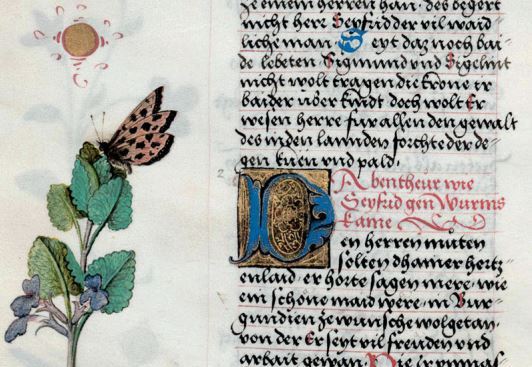
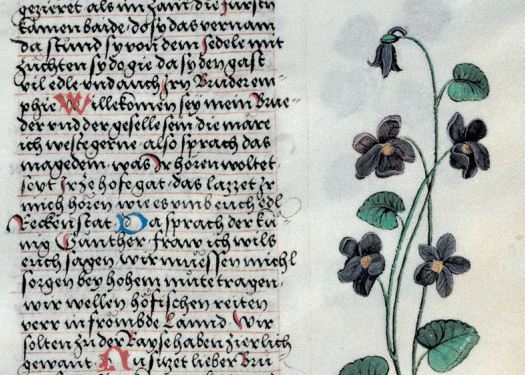
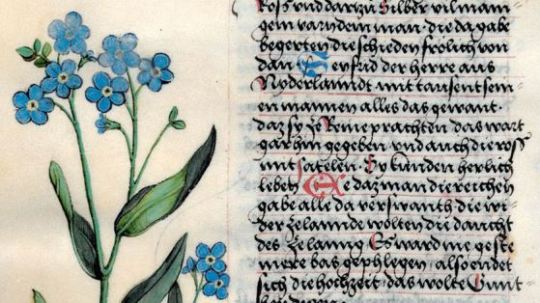
Floral marginal illustrations alongside the text of the Nibelungenlied in the Ambraser Heldenbuch, 16th century.
Source: Österreichische Nationalbibliothek, Cod. Ser. nova 2663
57 notes
·
View notes
Text

I clearly had too much time on my hands because when I found pictures of the Österreichische Nationalbibliothek in Wien I took last December, I just couldn't shake the feeling they are so Aziraphale-coded!
So I added a little picture of my Aziraphale cosplay and some haiku I wrote for @sohoscribblers and viola.
It is certainly something?
The forbidden fruit.
Your lips made me a sinner
I won't beg for grace
#goodomens#wien#vienna#books & libraries#books#library#aziraphale#good omens cosplay#aziraphale cosplay
17 notes
·
View notes
Text

Mary Warner im Gegenlicht, Heinrich Kühn, 1908. © Österreichische Nationalbibliothek, Bildarchiv, Wien
10 notes
·
View notes
Photo

Austrian National Library
photo By Richard Hopkins - Flickr: Österreichische Nationalbibliothek, CC BY 2.0, https://commons.wikimedia.org/w/index.php?curid=19799030
2 notes
·
View notes
Text




GOD I WANT TO GO TO THERE (Österreichische Nationalbibliothek)
2 notes
·
View notes